Indigenous Activists Are Leading the Fight Against Fossil Fuel Colonialism
The growing visibility and power of Indigenous movements have created enormous potential for fundamentally changing our world in a positive fashion.
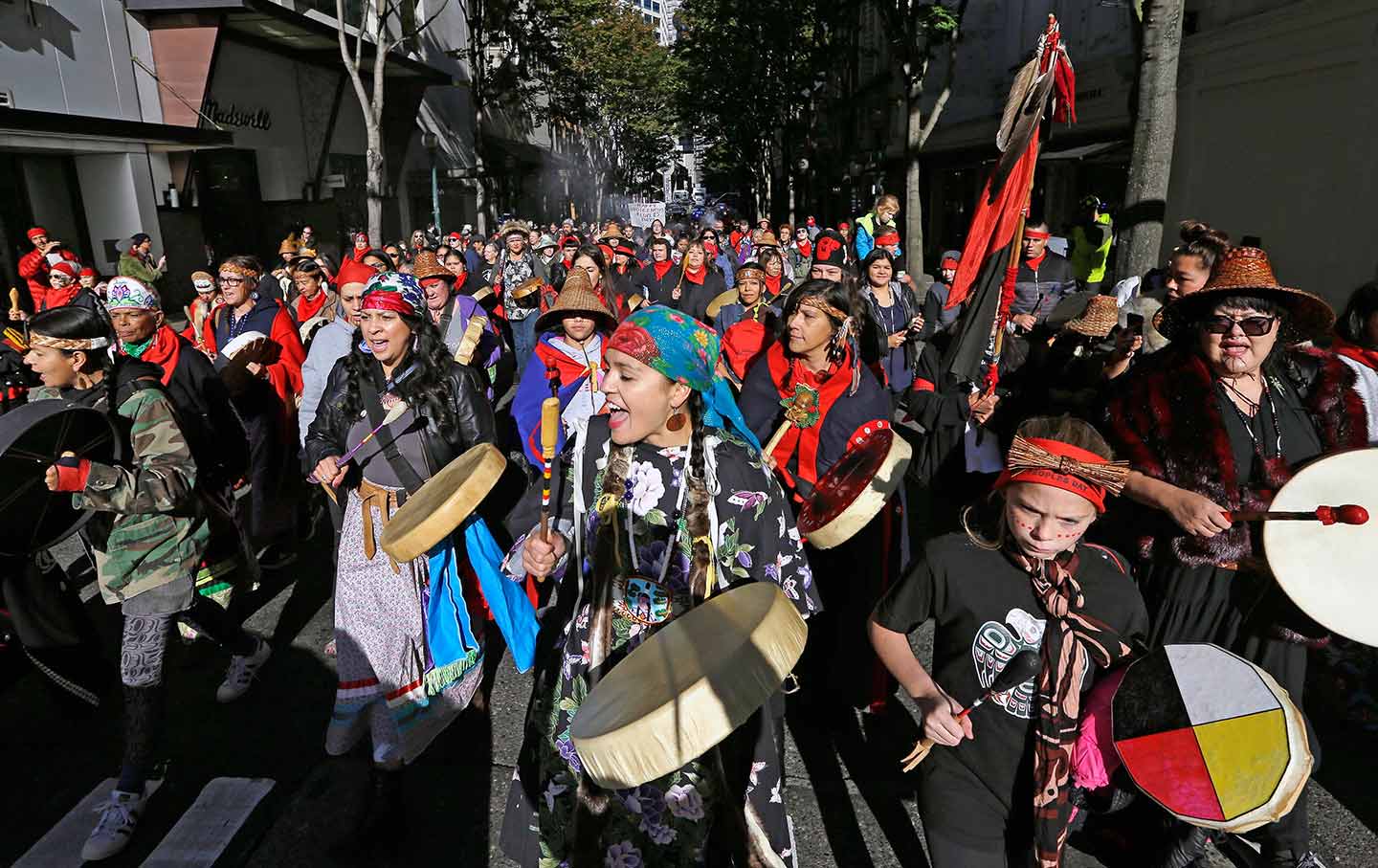
Drummers sing as they lead a march during an Indigenous Peoples’ Day event in Seattle on October 9, 2017.
(Elaine Thompson / AP)
This article originally appeared at TomDispatch.com. To stay on top of important articles like these, sign up to receive the latest updates from TomDispatch.com.
On August 9, 2001, in Colombia, riot police and private security forces from the Cerrejón coal mine—one of the largest open-pit coal mines in the world—surrounded the remote community of Tabaco. They then dragged residents out of their homes and bulldozed what remained of that town’s structures. There was, after all, coal under the town and the mine’s owner, Exxon Mobil Corporation, wanted to access it. Since that date, the displaced residents of Tabaco have been fighting for compensation and (as guaranteed by both Colombian and international law) the reconstruction of their community. So far, no such luck.
Note that August 9 was then and is now the International Day of the World’s Indigenous Peoples, as the United Nations first declared in 1994. That was, in fact, the day when the newly formed UN Working Group on Indigenous Populations had its initial meeting in 1982.
Indigenous peoples have, of course, been under siege by colonizers for hundreds of years, even if their struggles for land and sovereignty only gained true international recognition in the late 20th century, a time when, ironically enough, they were experiencing new assaults on their lands globally. Since World War II, the unprecedented growth of both the world’s population and global consumption levels have pushed resource use far beyond any limits once imagined. And that scramble for resources only accelerated starting in the 1990s, which meant further encroachment on Indigenous territories—and, of course, an onrushing climate catastrophe.
Since then, however, the growing visibility and power of Indigenous movements have created enormous potential for fundamentally changing our world in a positive fashion. While the struggle of the inhabitants of Tabaco has in many ways been emblematic of Indigenous struggles against extractivism, the story is more complicated. First, Tabaco itself is not, in fact, an Indigenous community but one largely descended from Africans brought to the New World as slaves. A narrow emphasis on Indigeneity can make it hard to take in non-Indigenous land and environmental struggles. Moreover, not all Indigenous people are rural and the stereotype flattens the realities of such movements. Finally, popular but misguided ideas about indigeneity underlie the claim to a Jewish “Indigenous” presence in Palestine, one that divorces Indigeneity from its historical context.
A deeper dive into colonialism and Indigenous peoples can help clarify the nature of such movements today and, curiously enough, some of the debates around the Israeli-Palestinian question as well.
Defining Indigenous Peoples
Indigenous peoples today live under the jurisdiction of nation states and those countries define them in varying ways. In the United States, you are Indigenous if you belong to a federally recognized tribe. Colombia formalized legal recognition of Indigeneity in its 1991 constitution and laws that outlined the specific requirements a group must fulfill to become an official “Indigenous community.” Like other Latin American countries, it also legally recognizes Afro-descended communities like Tabaco. In the case of Israel and Palestine, there is no legal “Indigenous” status at all, though the concept has become a weapon in a political debate about who has rights to historic Palestine.
Indigenous peoples in the Americas were first identified as “Indians” by European colonizers. Those so defined had no prior sense of common identity, which only developed through the historical experience of colonization. In the United States, pan-Indian organizations initially emerged in response to the creation of residential boarding schools to forcibly “assimilate” Native American children in what were functionally educational versions of prisons. Starting in the late 19th century, children from widely varying homelands speaking different languages were forced into the same regimented schools.
The more radical American Indian Movement emerged in the late 20th century among Indians from different nations thrown together, thanks in part to the 1950s Voluntary Relocation Program that brought more than 100,000 Native Americans to cities like Chicago, Denver, and Los Angeles. Not surprisingly, collective Indigenous identities in the United States drew not on long-standing language, cultural, or ethnic affinities but on the common experience of conquest and dispossession.
Only in the 1980s did international law begin to recognize a common historical experience among Indigenous peoples globally. The UN Special Rapporteur on Indigenous Affairs offered what has become a foundational definition of Indigenous peoples, even though the United Nations never formally adopted it: “Indigenous communities, peoples and nations are those which, having a historical continuity with pre-invasion and pre-colonial societies that developed on their territories, consider themselves distinct from other sectors of the societies now prevailing on those territories.” This formulation was later expanded to acknowledge the Indigenous peoples of Africa and Asia whose experience of “subjugation, marginalization, dispossession, exclusion, or discrimination” generally came from the independent nation-states that governed their territory rather than directly from European colonization.
Two important innovations in international law, the ILO Convention 169 of 1989 and the UN Declaration on the Rights of Indigenous Peoples (UNDRIP) of 2007, reflected the growing strength of global Indigenous activism and acknowledged the growing threat of extractivist assaults on Indigenous lands. ILO 169 created a legal requirement for “prior consultation”—that is, a requirement that governments offer Indigenous communities a voice in any development projects that might affect their lands. The UNDRIP strengthened that provision by giving communities the right to veto projects they opposed by mandating that governments obtain “free, prior, and informed consent” before embarking on any project affecting Indigenous lands.
You probably won’t be surprised to learn that neither the United States nor Israel ratified ILO 169 and neither supported the UNDRIP. Colombia, on the other hand, ratified ILO 169, incorporating it into its 1991 Constitution and extending such protections beyond Indigenous peoples to Afro-Colombian communities like Tabaco. Yet, in reality, as Tabaco’s experience shows, such legal rights continue to be violated.
Even as Colombia and other Latin American countries strengthened Indigenous rights, reformulating their nation-states as proudly multilingual, multicultural, and plurinational, Israel’s 2018 nation-state law further entrenched Jewish ethnonationalism there.
Fossil Colonialism
Fossil fuel use creates massive levels of toxic waste, including (but not limited to) the greenhouse gas emissions now overheating our planet. Increasing fossil fuel use—the industrial revolution in each of its phases—also accelerated the use of other resources. Industry can keep producing more and better stuff, but only by extracting more resources and producing ever more waste. As a result, geographical expansion—whether labeled Manifest Destiny, colonialism, or globalization—has been inseparable from the increasing use of energy, while both were also intimately tied to a 500-year assault on Indigenous lands and ways of life that continues today.
Remarkably enough, despite centuries of colonial expansion, Indigenous peoples still control about a quarter of the planet’s land—mostly (you won’t be surprised to learn) areas ignored by industrial colonizers because they were too cold, too hot, too wet, too dry, too high, too low, or too apparently resource-poor to be deemed useful. However, this century’s relentless push for coal, oil, and natural gas, as well as the growing demand for “clean” energy resources like biofuels, copper, lithium, and rare earth elements, dams for hydropower, and land for solar and wind farms, has pushed the geographic reach of extractivism into new Indigenous territories. And the toxic waste from extraction and production, including greenhouse gas emissions, is at the heart of the present environmental catastrophes that affect us all, but disproportionately Indigenous, poor, and marginalized communities.
Tabaco’s history reflects the experiences and fates of so many self-liberated Afro-descended peoples who established their own communities, some in still-autonomous Indigenous territories, throughout Latin America over the past centuries. Like Indigenous communities, they were rural-, land-, and subsistence-based. And like Indigenous communities, their communities predated the nation-states that later engulfed them. Today, like Tabaco, they find themselves under threat from a modern fossil-fuelized version of colonialism.
Are Indigenous People Natural Environmentalists?
The resistance of Indigenous peoples to extractivism has made them crucial protagonists in today’s environmental and climate movements. But that’s only part of the story.
Colonial ideologies long romanticized Indigenous peoples as living in harmony with the land and nature—the “noble savage” who inhabited an idealized past. This view had a dark side, too: Europeans also labeled them lazy, indolent, standing in the way of progress, and in desperate and eternal need of European tutelage.
Such colonial constructions offered useful rationalizations for destroying even imperial, technologically advanced Indigenous polities like the Aztec and Inca empires that controlled and transformed nature every bit as profoundly as did contemporaneous European societies. Conquest of what they called “the new world” turned European fantasies into reality, as Indigenous hierarchies were flattened and Indigenous peoples dispossessed, enslaved, marginalized, or ruralized. What began in 1492 would only continue with the Indian removal of the 1830s in the United States, Argentina’s “conquest of the desert” in the late 19th century, and what some Indigenous scholars have termed the fourth (or fifth) conquest occurring today with neo-extractivism.
Fossil colonialism created a world in which socioeconomic and ethnic categories came to overlap—but not completely. Ramachandra Guha identified “ecosystems peoples,” whose economies and cultures were based on long-term symbiotic relationships with their lands (and they were not all Indigenous). Then, of course, there were the industrializing “omnivores” whose technological and geographical reach knew (and knows) no bounds. Whether European or not, such voracious omnivores were also colonizers and industrializers. Rural, land-based ecosystem peoples, whether Indigenous, Afro-descended, or neither, tend to possess environmental values that look quite different from what passes for environmentalism among so many industrialized omnivores. Theirs is about changing the global economic system, not giving corporations in the global north yet more incentives to extract more from the global south.
Popular
“swipe left below to view more authors”Swipe →Today, Indigenous people are indeed frequently “land-based,” but they remain Indigenous even if they have been displaced, whether voluntarily or not, from their rural communities (or in the United States, their reservations). Most Indigenous people in the Americas now do not live in peasant or rural communities but in urban areas. Some Native American tribal governments and members have even embraced extractive industries like oil and coal on their reservations and they are still Indigenous, even if they don’t match the colonial stereotype.
It’s the historical continuity with people who inhabited a territory prior to those who founded today’s nation-states that makes people Indigenous. In Latin America, Afro-descended peoples share this “priority” not by their ancestors’ presence prior to 1492 but because of their marginalization by the nation-states founded in the 1800s.
Israel and Palestine: Who Is Indigenous?
When I first became involved with Palestinian rights activism during the 1982 Israeli invasion of Lebanon, the term “Indigenous” never arose. There were hints, however. Zionists argued that biblical history connected Jews to the land, and French historian Maxime Rodinson situated European Zionism in its historical context of European colonialism and colonial thought, presaging what later became settler colonial theory.
Today, the question of who is “Indigenous” comes up regularly as Palestinians emphasize their family and ancestral ties to the land from which they were displaced, while mainstream Jewish and Zionist organizations claim that Jews are “native and indigenous” to Palestine. They also insist that Israeli Jews cannot be considered colonizers because, unlike other European ones, they “came to a homeland” and there was and is “no ‘motherland’” to which they can return. Israeli historian Benny Morris typically relied on the narrowest definition of colonialism (as “the policy and practice of an imperial power acquiring political control over another country”) to insist that European Zionists couldn’t be colonizers since they were not agents of a state exercising imperial power.
Such arguments fundamentally distort the scholarship of Indigeneity and settler colonialism. Indigenous people are those whose presence predates the nation-state formed on their territory: in this case, the Palestinians. The Israelis, while cherry-picking from the scholarship on Indigeneity, ignore the basic fact that the state is theirs.
European colonialism has had many faces. Scholars have distinguished “franchise” colonialism (as with much of the British imperial project in India and Africa), in which a small number of colonial bureaucrats cycle in and out of a colony to enforce systems of governance and extraction, from settler colonialism. A classic example of the latter is British North America, where the goal was to eliminate, rather than rule over, native populations, and replace them with a flood of European immigrants.
Of course, such categories are “ideal” types (however less than ideal they proved to be in reality). Most European colonial projects had both settler and franchise characteristics. In fact, one thing the “Jewish-Indigenous” argument about Israel omits is the British Mandate’s (1920-1948) role in fostering the Zionist project in Palestine. It also ignores the fact that most settler colonies were populated not by direct representatives of the colonial power but by unwanted populations of prisoners, religious or ethnic minorities, enslaved people (mostly Africans), indentured or contract laborers, or, in the case of Palestine, European and later Arab and other Jews.
Settler colonialism in North America began in the 1600s but continued long after the United States became an independent country. After that, it wasn’t an outside ruler but a national government that promoted the mass immigration of often impoverished and excluded Europeans to its shores.
Latin America’s history also offers overlapping examples of different types of colonial enterprises. In addition to the Spanish religious and royal officials sent to establish foreign rule, adventurers and non-Castilians made their way to the Americas in both official and unofficial capacities. The colonial governments mistrusted American-born “Creoles” of European origin as promoters of their own interests rather than that of the ruling imperial powers, even if they were also natural allies in controlling recalcitrant indigenous, African, and Afro-descended populations.
Creole elites played a major role in Latin America’s eventual split with Spain and in establishing independent countries there in the 19th century. Latin America’s new countries, like the newly independent United States, did not, of course, offer much independence for Indigenous and Afro-descended peoples. And like the United States, they promoted European immigration to whiten their populations, while continuing the project of conquering, missionizing, and otherwise eliminating Indigenous peoples and identities.
Today, amid the brutality in Gaza, it’s worth remembering that the creation of Israel in Palestine, its ongoing genocide in Gaza, and its current settlement and immigration policies, share many parallels with those earlier settler colonial projects. Israel’s extractivist projects (especially of water on the West Bank and gas off the coast of Gaza) also place it firmly among today’s fossil colonizers.
There are many reasons for Washington’s fervent support for Israel, but what Secretary of State Henry Kissinger described as the US need for Israel as a reliable “cop on the beat” or, as Secretary of State Alexander Haig once put it, an unsinkable American “aircraft carrier” in the oil-rich Middle East, certainly plays a major role. So does the colonial view that Israel represents technological and ideological modernity in a retrograde Arab world.
On August 9, we honor the world’s Indigenous peoples. Let’s move beyond stereotypes and recognize the ideas, movements, and rights of all peoples formerly and still subject to the violence of fossil colonialism. That includes those displaced from the Colombian town of Tabaco and those in the besieged territory of Gaza.
Disobey authoritarians, support The Nation
Over the past year you’ve read Nation writers like Elie Mystal, Kaveh Akbar, John Nichols, Joan Walsh, Bryce Covert, Dave Zirin, Jeet Heer, Michael T. Klare, Katha Pollitt, Amy Littlefield, Gregg Gonsalves, and Sasha Abramsky take on the Trump family’s corruption, set the record straight about Robert F. Kennedy Jr.’s catastrophic Make America Healthy Again movement, survey the fallout and human cost of the DOGE wrecking ball, anticipate the Supreme Court’s dangerous antidemocratic rulings, and amplify successful tactics of resistance on the streets and in Congress.
We publish these stories because when members of our communities are being abducted, household debt is climbing, and AI data centers are causing water and electricity shortages, we have a duty as journalists to do all we can to inform the public.
In 2026, our aim is to do more than ever before—but we need your support to make that happen.
Through December 31, a generous donor will match all donations up to $75,000. That means that your contribution will be doubled, dollar for dollar. If we hit the full match, we’ll be starting 2026 with $150,000 to invest in the stories that impact real people’s lives—the kinds of stories that billionaire-owned, corporate-backed outlets aren’t covering.
With your support, our team will publish major stories that the president and his allies won’t want you to read. We’ll cover the emerging military-tech industrial complex and matters of war, peace, and surveillance, as well as the affordability crisis, hunger, housing, healthcare, the environment, attacks on reproductive rights, and much more. At the same time, we’ll imagine alternatives to Trumpian rule and uplift efforts to create a better world, here and now.
While your gift has twice the impact, I’m asking you to support The Nation with a donation today. You’ll empower the journalists, editors, and fact-checkers best equipped to hold this authoritarian administration to account.
I hope you won’t miss this moment—donate to The Nation today.
Onward,
Katrina vanden Heuvel
Editor and publisher, The Nation
More from The Nation
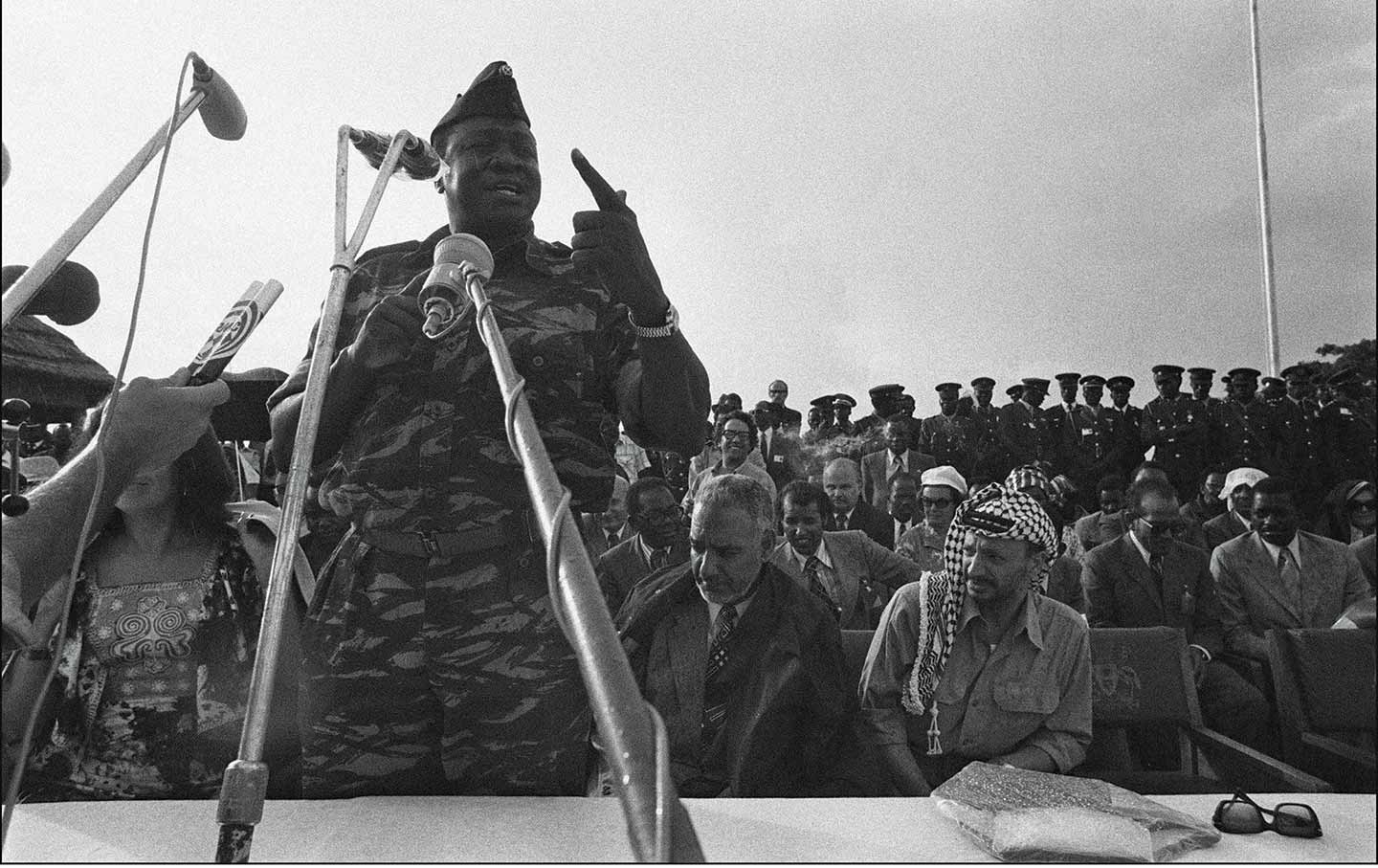
Mahmood Mamdani’s Uganda Mahmood Mamdani’s Uganda
In his new book Slow Poison, the accomplished anthropologist revisits the Idi Amin and Yoweri Museveni years.

The US Is Looking More Like Putin’s Russia Every Day The US Is Looking More Like Putin’s Russia Every Day
We may already be on a superhighway to the sort of class- and race-stratified autocracy that it took Russia so many years to become after the Soviet Union collapsed.

Israel Wants to Destroy My Family's Way of Life. We'll Never Give In. Israel Wants to Destroy My Family's Way of Life. We'll Never Give In.
My family's olive trees have stood in Gaza for decades. Despite genocide, drought, pollution, toxic mines, uprooting, bulldozing, and burning, they're still here—and so are we.
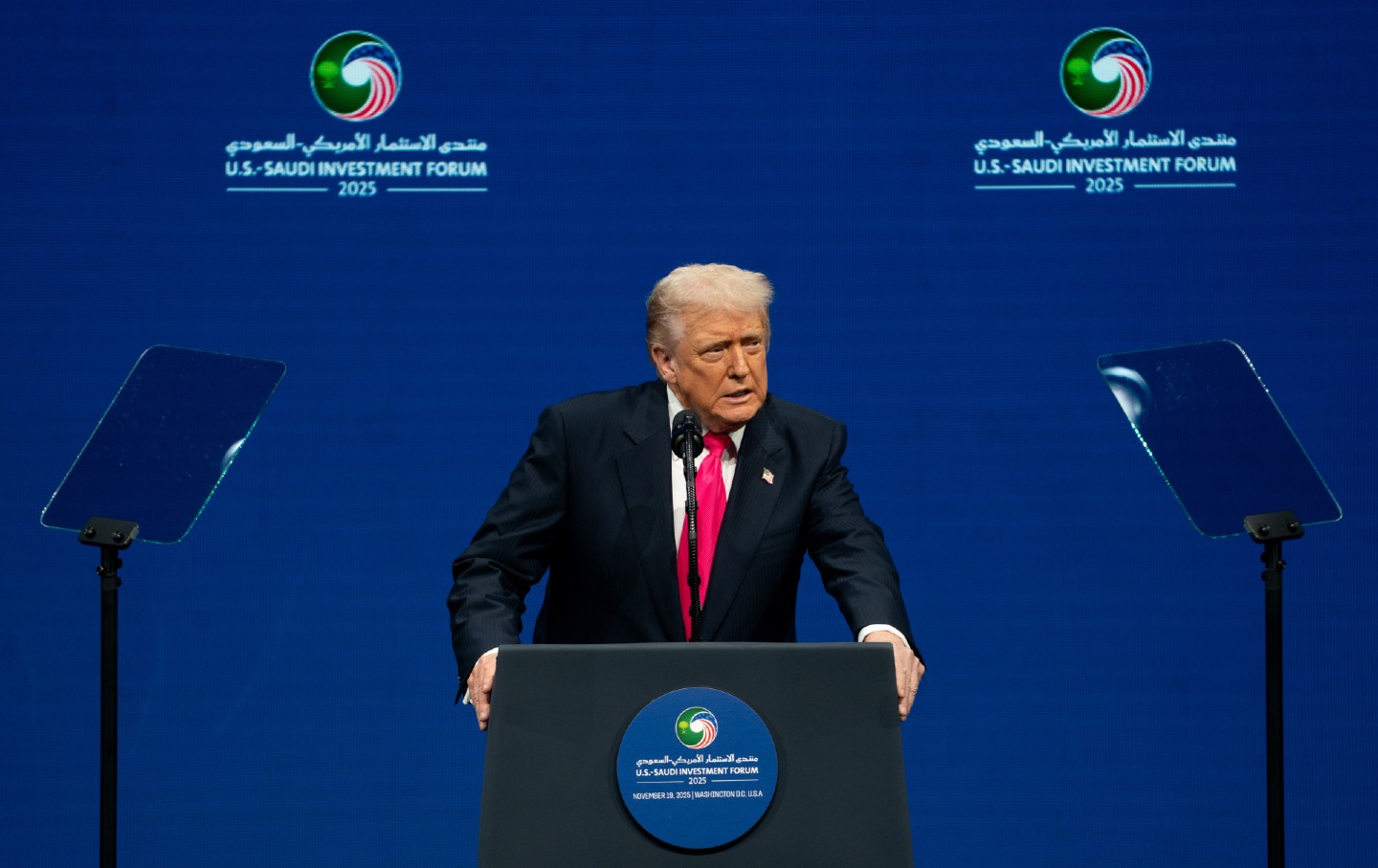
Trump’s National Security Strategy and the Big Con Trump’s National Security Strategy and the Big Con
Sense, nonsense, and lunacy.
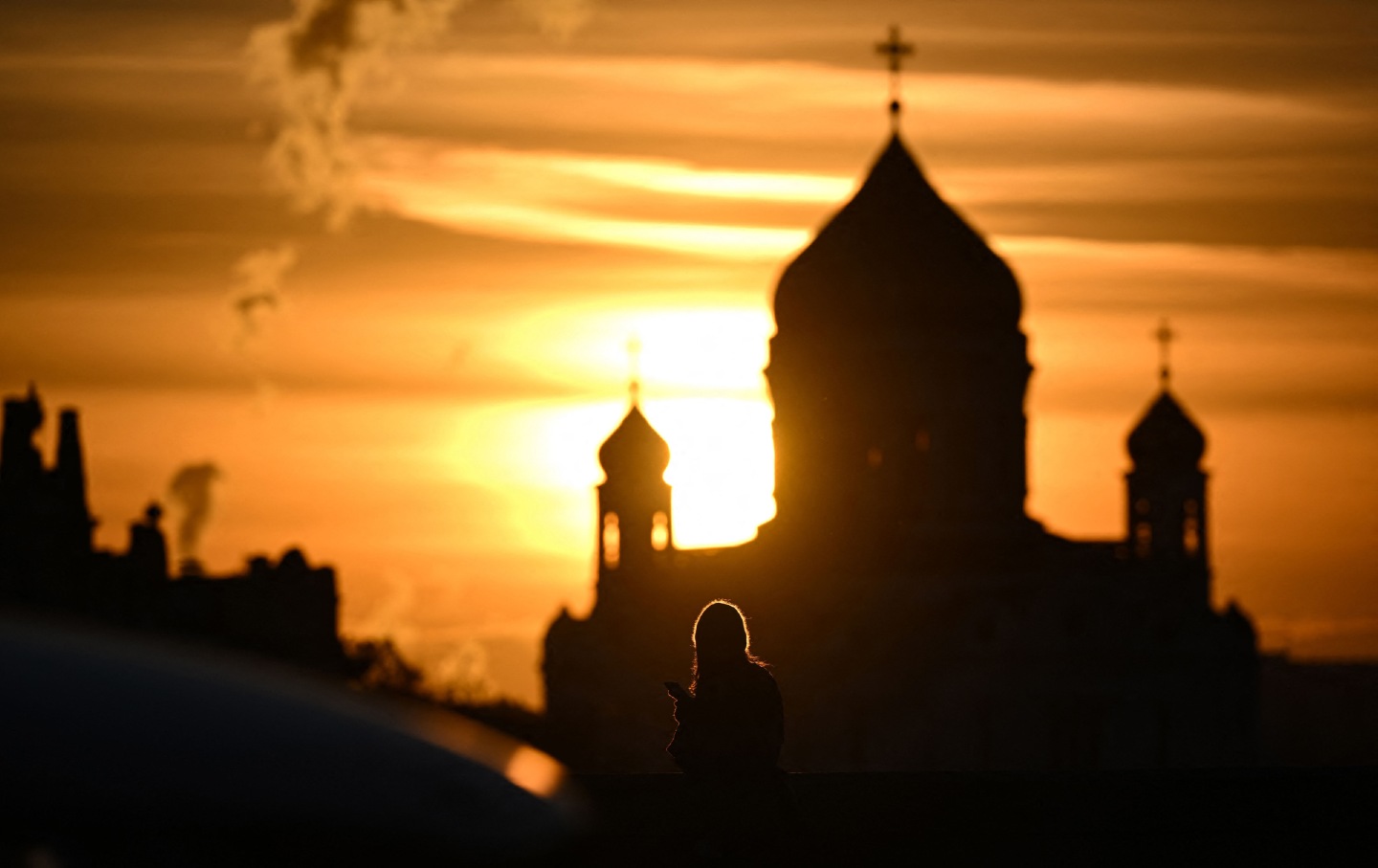
Does Russian Feminism Have a Future? Does Russian Feminism Have a Future?
A Russian feminist reflects on Julia Ioffe’s history of modern Russia.
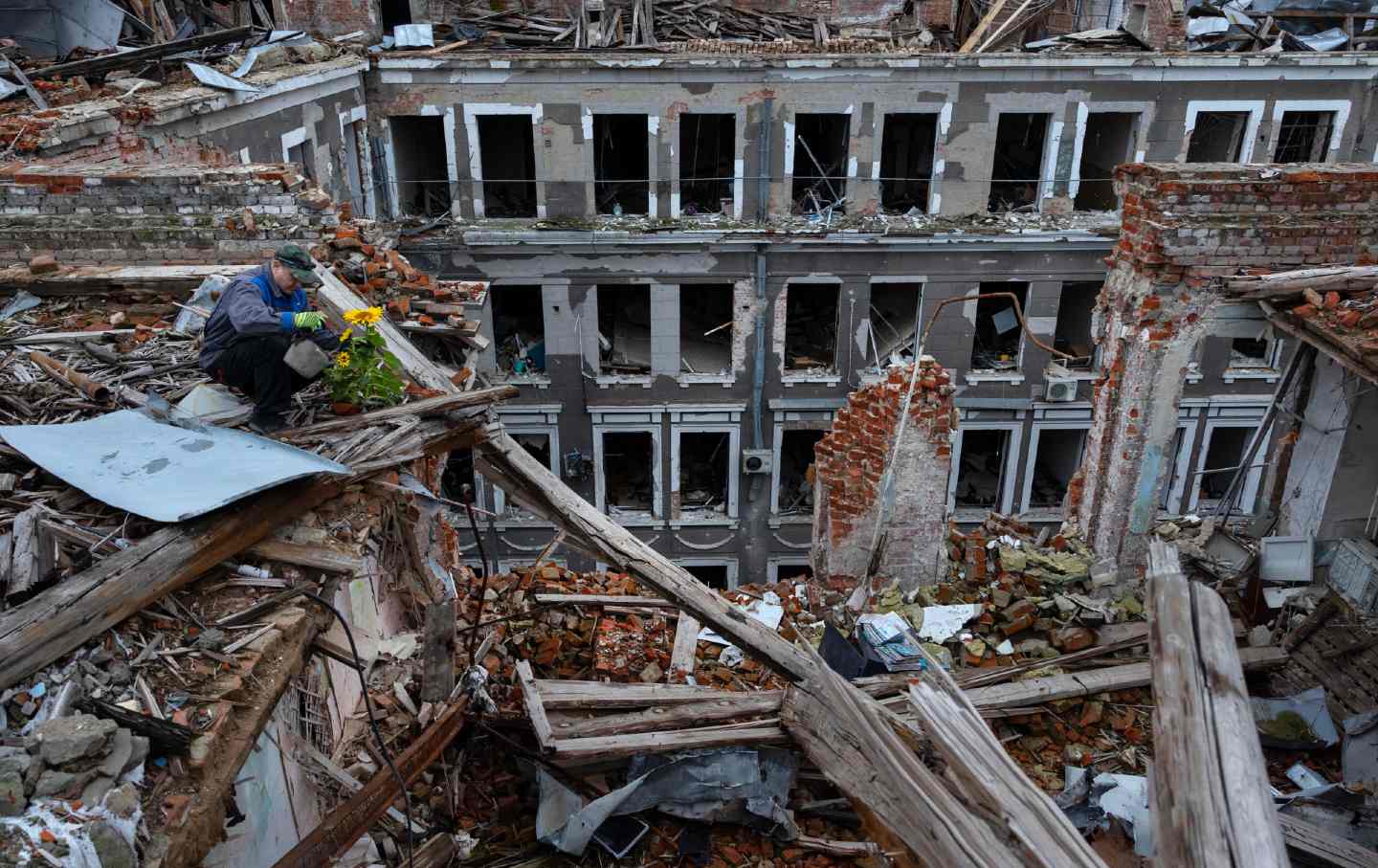
Ukraine’s War on Its Unions Ukraine’s War on Its Unions
Since the start of the war, the Ukrainian government has been cracking down harder on unions and workers’ rights. But slowly, the public mood is shifting.


